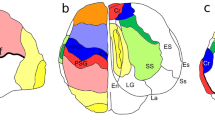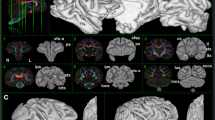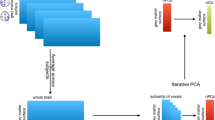Abstract
In addition to a large (chimpanzee-sized) and heavily convoluted brain, one of the most striking neurobiological features in pinnipeds is the large size of the head of the caudate nucleus, which dwarfs the rest of the striatum. Although previous research has suggested carnivore striatum is small in comparison to that of primates, there are limited volumetric data on separate striatal structures in carnivores. Therefore, the apparent functional implication of a potentially hypertrophic caudate to carnivores has not been discussed. Here, for the first time, we obtained separate volumetric measurements of caudate and putamen in California sea lions and coyotes. Exemplars of both species had very large caudate nuclei, approximately 1/75th of total brain volume. In both the sea lion and coyote, the caudate dwarfed the putamen at a ratio of 13 to 1 or greater, a finding in strong contrast to measurements showing larger putamen than caudate in primates. In addition, using post-mortem diffusion tensor brain imaging, we mapped and compared white matter connections between the dorsal caudate and the motor, premotor and frontopolar, and orbitofrontal cortices in healthy adult sea lions and healthy adult coyotes. The sea lions showed some evidence of greater premotor and frontopolar connectivity. These findings bear on previously underexplored striatal characteristics of large carnivores, and we discuss potential interpretations related to cognitive flexibility and sensorimotor transformation.




Similar content being viewed by others
References
Abramson JZ, Hernández-Lloreda V, Call J, Colmenares F (2011) Relative quantity judgments in South American sea lions (Otaria flavescens). Anim Cogn 14(5):695
Balleine BW, Delgado MR, Hikosaka O (2007) The role of the dorsal striatum in reward and decision making. J Neurosci 27(31):8161–8165
Basser PJ, Mattiello J, LeBihan D (1994) Estimation of the effective self-diffusion tensor from the NMR spin echo. J Magn Reson Ser B 103(3):247–254
Bauer GB, Cook PF, Harley HE (2020) The relevance of ecological transitions to intelligence in marine mammals. Front Psychol 11
Behrens TE, Woolrich MW, Jenkinson M, Johansen-Berg H, Nunes RG, Clare S, Smith SM (2003) Characterization and propagation of uncertainty in diffusion-weighted MR imaging. Magn Reson Med 50(5):1077–1088
Behrens TE, Berg HJ, Jbabdi S, Rushworth MF, Woolrich MW (2007) Probabilistic diffusion tractography with multiple fibre orientations: What can we gain? Neuroimage 34(1):144–155
Berns GS, Brooks AM, Spivak M (2012) Functional MRI in awake unrestrained dogs. PLoS ONE 7(5):e38027
Berns GS, Cook PF, Foxley S, Jbabdi S, Miller KL, Marino L (2015) Diffusion tensor imaging of dolphin brains reveals direct auditory pathway to temporal lobe. Proc R Soc b Biol Sci 282(1811):20151203
Bowyer RT (1987) Coyote group size relative to predation on mule deer
Buxton RB (1993) The diffusion sensitivity of fast steady-state free precession imaging. Magn Reson Med 29(2):235–243
Campagna C, Harcourt R (eds) (2021) Ethology and behavioral ecology of Otariids and the Odobenid. Springer, New York
Clarke HF, Robbins TW, Roberts AC (2008) Lesions of the medial striatum in monkeys produce perseverative impairments during reversal learning similar to those produced by lesions of the orbitofrontal cortex. J Neurosci 28(43):10972–10982
Cook PF, Prichard A, Spivak M, Berns GS (2016) Awake canine fMRI predicts dogs’ preference for praise vs food. Soc Cogn Affect Neurosci 11(12):1853–1862
Cook PF, Berns GS, Colegrove K, Johnson S, Gulland F (2018) Postmortem DTI reveals altered hippocampal connectivity in wild sea lions diagnosed with chronic toxicosis from algal exposure. J Comp Neurol 526(2):216–228
Cook P, Reichmuth C, Hanke FD (2021) The mind of a Sea Lion. Ethology and behavioral ecology of Otariids and the Odobenid. Springer, Cham, pp 323–345
Cui DM, Yan YJ, Lynch JC (2003) Pursuit subregion of the frontal eye field projects to the caudate nucleus in monkeys. J Neurophysiol 89(5):2678–2684
Dahlin E, Neely AS, Larsson A, Backman L, Nyberg L (2008) Transfer of learning after updating training mediated by the striatum. Science 320(5882):1510–1512
Datta R, Lee J, Duda J, Avants BB, Vite CH, Tseng B, Aguirre GK (2012) A digital atlas of the dog brain. PLoS ONE 7(12):e52140
De Roy T, Espinoza ER, Trillmich F (2021) Cooperation and opportunism in Galapagos sea lion hunting for shoaling fish. Ecol Evol 11(14):9206–9216
dos Santos LM, Ferro MM, Mota-Ortiz SR, Baldo MV, da Cunha C, Canteras NS (2007) Effects of ventrolateral striatal inactivation on predatory hunting. Physiol Behav 90(4):669–673
Dunbar RI, Shultz S (2007) Understanding primate brain evolution. Philos Trans R Soc b Biol Sci 362(1480):649–658
Finkelstein A, Derdikman D, Rubin A, Foerster JN, Las L, Ulanovsky N (2015) Three-dimensional head-direction coding in the bat brain. Nature 517(7533):159–164
Finlay BL, Darlington RB (1995) Linked regularities in the development and evolution of mammalian brains. Science 268(5217):1578–1584
Flaherty AW, Graybiel AM (1993) Output architecture of the primate putamen. J Neurosci 13(8):3222–3237
Fox KC, Muthukrishna M, Shultz S (2017) The social and cultural roots of whale and dolphin brains. Nat Ecol Evol 1(11):1699–1705
Gahnstrom CJ, Spiers HJ (2020) Striatal and hippocampal contributions to flexible navigation in rats and humans. Brain Neurosci Adv 4:2398212820979772
Genty E, Roeder JJ (2006) Self-control: why should sea lions, Zalophus californianus, perform better than primates? Anim Behav 72(6):1241–1247
Ghahremani DG, Monterosso J, Jentsch JD, Bilder RM, Poldrack RA (2010) Neural components underlying behavioral flexibility in human reversal learning. Cereb Cortex 20(8):1843–1852
Ghysen A (2003) The origin and evolution of the nervous system. Int J Dev Biol 47(7–8):555–562
Grahn JA, Parkinson JA, Owen AM (2008) The cognitive functions of the caudate nucleus. Prog Neurobiol 86(3):141–155
Grisham W, Greta S, Schottler N, Tomita W, Burre A, Rostamian D, Thomas ST (2020) Brain volume fractions in mammals in relation to behavior in carnivores, primates, ungulates, and rodents. Brain Behav Evol 95(2):102–112
Gutman DA, Keifer OP Jr, Magnuson ME, Choi DC, Majeed W, Keilholz S, Ressler KJ (2012) A DTI tractography analysis of infralimbic and prelimbic connectivity in the mouse using high-throughput MRI. Neuroimage 63(2):800–811
Haruno M, Kawato M (2006) Different neural correlates of reward expectation and reward expectation error in the putamen and caudate nucleus during stimulus-action-reward association learning. J Neurophysiol 95(2):948–959
Heiervang E, Behrens TEJ, Mackay CE, Robson MD, Johansen-Berg H (2006) Between session reproducibility and between subject variability of diffusion MR and tractography measures. Neuroimage 33(3):867–877
Herculano-Houzel S (2019) Longevity and sexual maturity vary across species with number of cortical neurons, and humans are no exception. J Comp Neurol 527(10):1689–1705
Herculano-Houzel S (2009) The human brain in numbers: a linearly scaled-up primate brain. Front Hum Neurosci 31
Hikosaka O, Sakamoto M, Usui S (1989) Functional properties of monkey caudate neurons. I. Activities related to saccadic eye movements. J Neurophysiol 61(4):780–798
Hochner B (2013) How nervous systems evolve in relation to their embodiment: what we can learn from octopuses and other molluscs. Brain Behav Evol 82(1):19–30
Iwaniuk AN (2010) Comparative brain collections are an indispensable resource for evolutionary neurobiology. Brain Behav Evol 76(2):87
Jerison HJ (2019) Principles of the evolution of the brain and behavior. Evolution, Brain, and Behavior: Persistent Problems. Psychology Press, London, pp 23–45
Jürgens U (2002) Neural pathways underlying vocal control. Neurosci Biobehav Rev 26(2):235–258
Kastak CR, Schusterman RJ, Kastak D (2001) Equivalence classification by California sea lions using class-specific reinforcers. J Exp Anal Behav 76(2):131–158
Kimura M (1990) Behaviorally contingent property of movement-related activity of the primate putamen. J Neurophysiol 63(6):1277–1296
Kirkby RJ (1969) Caudate nucleus lesions and perseverative behavior. Physiol Behav 4(4):451–454
Klanker M, Feenstra M, Denys D (2013) Dopaminergic control of cognitive flexibility in humans and animals. Front Neurosci 7:201
Lau B, Glimcher PW (2007) Action and outcome encoding in the primate caudate nucleus. J Neurosci 27(52):14502–14514
Marino L (2004) Dolphin cognition. Curr Biol 14(21):R910–R911
McKnight JC, Ruesch A, Bennett K, Bronkhorst M, Balfour S, Moss SE, Hastie GD (2021) Shining new light on sensory brain activation and physiological measurement in seals using wearable optical technology. Philos Trans R Soc B 376(1830):20200224
McNab JA, Jbabdi S, Deoni SC, Douaud G, Behrens TE, Miller KL (2009) High resolution diffusion-weighted imaging in fixed human brain using diffusion-weighted steady state free precession. Neuroimage 46(3):775–785
Miller KL, Stagg CJ, Douaud G, Jbabdi S, Smith SM, Behrens TE, McNab JA (2011) Diffusion imaging of whole, post-mortem human brains on a clinical MRI scanner. Neuroimage 57(1):167–181
Miller KL, McNab JA, Jbabdi S, Douaud G (2012) Diffusion tractography of post-mortem human brains: optimization and comparison of spin echo and steady-state free precession techniques. Neuroimage 59(3):2284–2297
Montie EW, Pussini N, Schneider GE, Battey TW, Dennison S, Barakos J, Gulland F (2009) Neuroanatomy and volumes of brain structures of a live California sea lion (Zalophus californianus) from magnetic resonance images. Anat Record Adv Integr Anat Evol Biol Adv Integr Anat Evol Biol 292(10):1523–1547
Morgane PJ, Glezer II (1990) Sensory neocortex in dolphin brain. Sensory abilities of cetaceans. Springer, Boston, pp 107–136
Oelschläger HH (2008) The dolphin brain—a challenge for synthetic neurobiology. Brain Res Bull 75(2–4):450–459
Postle BR, D’Esposito M (1999) Dissociation of human caudate nucleus activity in spatial and nonspatial working memory: an event-related fMRI study. Cogn Brain Res 8(2):107–115
Postle BR, D’Esposito M (2003) Spatial working memory activity of the caudate nucleus is sensitive to frame of reference. Cogn Affect Behav Neurosci 3(2):133–144
Reep RL, Finlay BL, Darlington RB (2007) The limbic system in mammalian brain evolution. Brain Behav Evol 70(1):57–70
Ridgway SH, Brownson RH, Van Alstyne KR, Hauser RA (2019) Higher neuron densities in the cerebral cortex and larger cerebellums may limit dive times of delphinids compared to deep-diving toothed whales. PLoS ONE 14(12):e0226206
Rilling JK (2014) Comparative primate neuroimaging: insights into human brain evolution. Trends Cogn Sci 18(1):46–55
Sato K, Aoki K, Watanabe YY, Miller PJ (2013) Neutral buoyancy is optimal to minimize the cost of transport in horizontally swimming seals. Sci Rep 3(1):1–5
Sawyer EK, Turner EC, Kaas JH (2016) Somatosensory brainstem, thalamus, and cortex of the California sea lion (Zalophus californianus). J Comp Neurol 524(9):1957–1975
Schusterman RJ, Kastak D (1993) A California sea lion (Zalophus californianus) is capable of forming equivalence relations. Psychol Record 43(4):823–839
Schusterman RJ, Kellogg WN, Rice CE (1965) Underwater visual discrimination by the California sea lion. Science 147(3665):1594–1596
Schusterman RJ, Kastak CR, Kastak D (2002) The cognitive sea lion: Meaning and memory in the laboratory and in nature
Sea Lion Hunters (2013). https://www.youtube.com/watch?v=VX6XSqP6UVo
Sliwa J, Freiwald WA (2017) A dedicated network for social interaction processing in the primate brain. Science 356(6339):745–749
Sporns O (2007) Brain connectivity. Scholarpedia 2(10):4695
Travain T, Colombo ES, Grandi LC, Heinzl E, Pelosi A, Previde EP, Valsecchi P (2016) How good is this food? A study on dogs’ emotional responses to a potentially pleasant event using infrared thermography. Physiol Behav 159:80–87
Van Bourg J, Young JK, Alkhalifah R, Brummer S, Johansson E, Morton J, Wynne CD (2022) Cognitive flexibility and aging in coyotes (Canis latrans). J Comp Psychol
Vonk J, Leete JA (2017) Carnivore concepts: categorization in carnivores “bears” further study. Int J Comp Psychol 30:1–22
Washington SD, Hamaide J, Jeurissen B, Van Steenkiste G, Huysmans T, Sijbers J, Verhoye M (2018) A three-dimensional digital neurological atlas of the mustached bat (Pteronotus parnellii). Neuroimage 183:300–313
Whishaw IQ, O’Connor WT, Dunnett SB (1986) The contributions of motor cortex, nigrostriatal dopamine and caudate-putamen to skilled forelimb use in the rat. Brain 109(5):805–843
Wilson RP, Griffiths IW, Mills MG, Carbone C, Wilson JW, Scantlebury DM (2015) Mass enhances speed but diminishes turn capacity in terrestrial pursuit predators. Elife 4:e06487
Yeh FC, Verstynen TD, Wang Y, Fernández-Miranda JC, Tseng WYI (2013) Deterministic diffusion fiber tracking improved by quantitative anisotropy. PLoS ONE 8(11):e80713
Yin D, Valles FE, Fiandaca MS, Forsayeth J, Larson P, Starr P, Bankiewicz KS (2009) Striatal volume differences between non-human and human primates. J Neurosci Methods 176(2):200–205
Author information
Authors and Affiliations
Corresponding author
Additional information
Publisher's Note
Springer Nature remains neutral with regard to jurisdictional claims in published maps and institutional affiliations.
Rights and permissions
Springer Nature or its licensor holds exclusive rights to this article under a publishing agreement with the author(s) or other rightsholder(s); author self-archiving of the accepted manuscript version of this article is solely governed by the terms of such publishing agreement and applicable law.
About this article
Cite this article
Cook, P.F., Berns, G. Volumetric and connectivity assessment of the caudate nucleus in California sea lions and coyotes. Anim Cogn 25, 1231–1240 (2022). https://doi.org/10.1007/s10071-022-01685-7
Received:
Revised:
Accepted:
Published:
Issue Date:
DOI: https://doi.org/10.1007/s10071-022-01685-7




